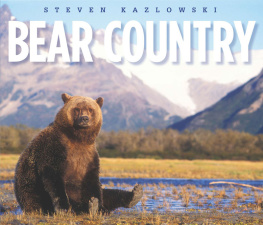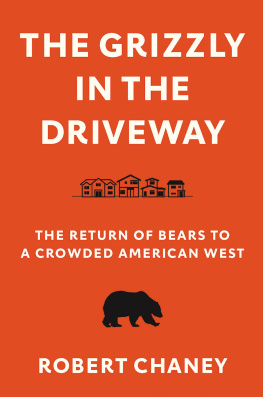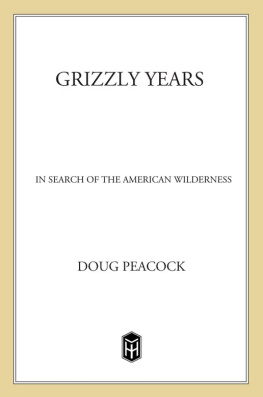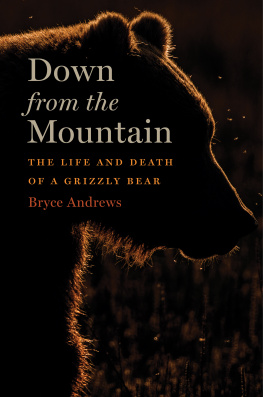Idahos Selway-Bitterroot Wilderness together with the Frank Church Wilderness constitute the largest roadless area in the Lower 48. All this land is prime and historical grizzly bear habitat. Yet, despite nearby grizzly populations in Montana, this vast region is tragically and bafflingly devoid of grizzly bears. How could this be? Michael Daxs unusually thorough book documents our public failure to reintroduce the great bear to its natural home.
Michael Dax expertly probes the economic, cultural, and political divides spawned by recent efforts to reintroduce grizzly bears into the Bitterroot Range.... This is a first-rate environmental history that will enlighten environmentalists, legislators, natural resource users, and others engaged in deciding the fate of public lands in the modern American West.
Michael Dax delivers a nuanced and compelling study of the interconnectedness of politics and the environment in the West. He ably tells a story that far too few know, and he does so with grace and clarity and skillfully avoids green-washing this topic.
Grizzly West
A Failed Attempt to Reintroduce Grizzly Bears in the Mountain West
Michael J. Dax
University of Nebraska Press | Lincoln & London
2015 by the Board of Regents of the University of Nebraska. All rights reserved.
Cover image iStockphoto.com/CSA-Archive
Author photo courtesy of the author
Publication of this volume was assisted by a grant from the Friends of the University of Nebraska Press.
Library of Congress Cataloging-in-Publication Data
Dax, Michael J.
Grizzly West: a failed attempt to reintroduce grizzly bears in the mountain West / Michael J. Dax.
pages cm
Includes bibliographical references and index.
ISBN 978-0-8032-6673-5 (cloth: alk. paper)
ISBN 978-0-8032-7854-7 (epub)
ISBN 978-0-8032-7855-4 (mobi)
ISBN 978-0-8032-7856-1 (pdf)
1. Grizzly bearReintroductionSelway-Bitterroot Wilderness (Idaho and Mont.) 2. Wildlife conservationPolitical aspectsSelway-Bitterroot Wilderness (Idaho and Mont.) I. Title.
QL 737. C 27 D 337 2015
599.784dc23
2015005401
The publisher does not have any control over and does not assume any responsibility for author or third-party websites or their content.
Contents
This project began as a term paper during my masters thesis under Dan Flores at the University of Montana. In a seminar class, Dan suggested that someone might write about a little-known attempt to reintroduce grizzly bears to the Selway-Bitterroot Wilderness, which was nearly visible from our classroom. After conducting some preliminary research at Dans urging, I realized the subjects potential given the complexity of the issue and the multitude of ethical and cultural questions it raised. So first and foremost, I owe an immense debt of gratitude to Dan Flores. His supportive advice and guidance throughout the project was heartening, and without his encouragement, I might not have pursued this project past my masters thesis. Our lengthy conversations about the West and its internal struggles helped me refine my thinking on the subject and develop the narrative arc of the story. Not only was he fully invested in the project from the first term paper through to the final manuscript, but without him, I most likely would have never heard of this forgotten piece of history. Also, when it comes to writing, Dan is a true original whose style is all his own. He encouraged his students to write with a similar freedom, and I hope his influence comes through in my writing.
After piecing a term paper together, I contacted Hank Fischer, a former representative of Defenders of Wildlife who was one of the chief architects of the plan to return grizzlies to the Bitterroots. Hank still lived in Missoula and was kind enough to grant me an interview, during which he offered to give me the box of materials he had collected over the course of the project. The box was sitting in his basement, and his wife had been urging him to get rid of it, so I was happy to take it off his hands. In this box I discovered a haphazard collection of memos, faxes, letters, emails, newspaper clippings, and various publications that no one had laid eyes on in more than a decade. It was beautifully disorganized, and it was all mine. If not for his generous donation, this project very likely would not have become what it did. During my other research efforts, I was able to find a handful of the sources contained within Hanks collection, but no other archive was nearly as robust as the one collecting dust in his basement. Hank remained engaged in my project while I wrote my thesis, and his support and comments were greatly appreciated.
While completing my masters thesis, Jeff Wiltse consistently asked me pointed questions and offered insightful suggestions that made the project stronger. Initially I was hesitant to tackle some of these questions on their merits because they challenged my own beliefs and understanding of the events about which I was writing, and I was nervous for the answers I would find. His questions cut to the core of the dilemma that introducing a potentially dangerous predator to the region created, and they forced me to grapple with difficult issues. I did my best to address his concerns, and the manuscript is undoubtedly stronger because of it. I would also like to thank Michael Patterson who brought a dose of hard science, policy, and firsthand recollection of the issue to my thesis committee. His influence on this book has been subtle, yet important.
Over the course of the project I interviewed a number of people who had been involved with the issue in varying capacities. Thank you to Chris Servheen, Mike Bader, Minette Glaser, Claire Kelly, and Hank Fischer for taking the time to recall events that occurred nearly twenty years ago and to share those memories with me. They filled holes in my narrative that no document alone could possibly have done.
I owe a thank-you to Dylan Huisken and Tom France for reading late drafts of the manuscript and helping me fine-tune my language and analysis. Thanks also to Zack Porter who was kind enough to take photos for the book and provide guidance on some of its other small elements. Barrett Hedges kindly loaned one of his many brilliant photographs for the book as well. I would also like to thank Clinton Lawson for our many conversations that helped me articulate a number of the ideas and theories that appear in the following pages, and for reassuring me throughout this process.
The Matthew Hanson Endowment at the University of Montana awarded me a generous grant that allowed me to continue my research and expand my project from a thesis into a book. This award afforded me the luxury of spending a magnificent summer researching, writing, and occasionally sneaking away to the Bitterroots for solace and restoration.
In this vein I cannot leave out Treasure State Donuts in Missoula, where I spent hours drinking coffee and working on this project the summer after finishing my masters thesis. By giving me free rein over as much counter space as I could possibly occupy, plenty of coffee and donuts, and the ability to continue working after they had closed for the day, I had access to a surprisingly conducive atmosphere for productive writing and creative thought.












